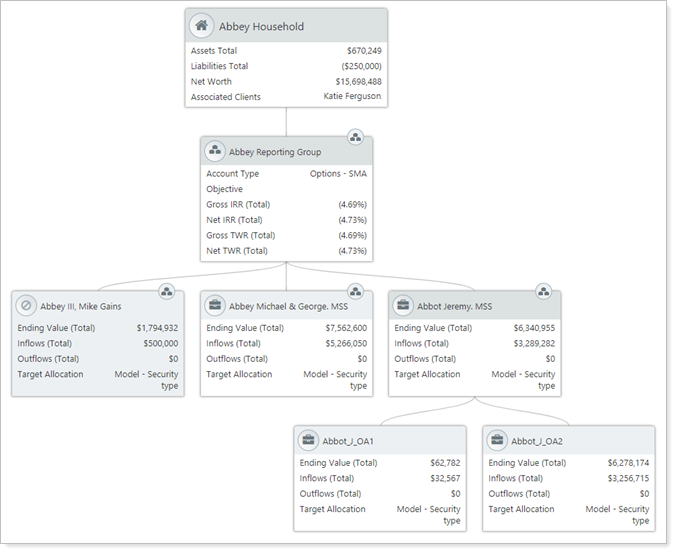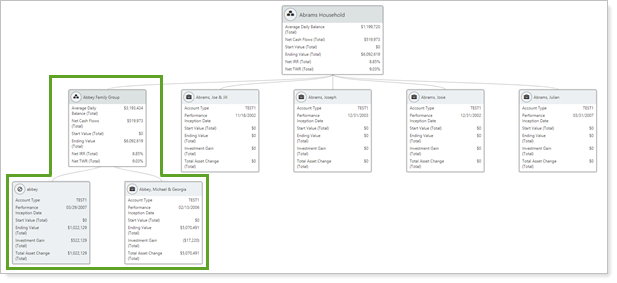 Back
Back
 Back Back |
Home > Advisor View > Reports > Dynamic and PDF Reports > Available Reports > Financial Planning Reports > Relationship Diagram
|
Relationship Diagram
|
|
| Applies to: | |||
|---|---|---|---|
| ✔ Dynamic | Mobile |
✔ Client Portal |
|
The relationship diagram shows how accounts, groups, and Households are connected with each other by displaying connections in a visual tree structure. Each entity is displayed on a card, and each card displays fully customizable data points. This diagram shows how accounts and groups are organized within groups and Households. It can also be useful for troubleshooting setup and understanding complicated Household structures.

You can change what data points you see on each tile type. Access the full relationship diagram Relationship Diagram and create a new report view.
In the relationship diagram, you'll find the following features:
Easily identify how entities relate to one another. See a tree mapping out connections between accounts, groups, and Households.
Include metrics for each entity. See such account details as account type, custodian, and primary owner, plus such Summary report details as returns, inflows and outflows, current value, and more.
Efficiently Switch to a related entity. Within a report, open the relationship diagram and click the entity icon in the left corner of a card to view the report for that entity. Click Quick Look button to learn more about the entity's group and Household membership.
The relationship diagram is generated for whatever entity is listed in the Find Data For list.
Account Level: If there is an account currently selected in the Find Data For list, the relationship diagram generated will start with that account.

Group Level: If there is an group currently selected in the Find Data For list, the relationship diagram generated will start with that group and display any accounts or groups added to the group.

The relationship diagram respects the entity display limitations of the report. For example, if a report doesn't display Households, only accounts and groups will be available for viewing in the relationship diagram on that report page. On the Relationship Diagram page itself, you can view any Households, groups, or accounts.
In the relationship diagram, you will find versatile settings that let you answer many questions about entity relationships, such as:
What accounts and groups are in this household? See a tree that maps connections between accounts, groups, and Households. Start the tree at any entity level to see all connections from that level downward, including all direct and indirect members.
Is this Household Correctly populated? Confirm the accuracy of Household, client, group, and account assignments and troubleshoot when it looks like something may have been inaccurately categorized.
What clients own which accounts? What returns or flows occurred in the accounts? Add a wide variety of data points to each card type, including primary owner, service team, returns, flows, and more.
Let's say you're looking at a Holdings report and you notice some unique holdings you didn't expect to see in that group. You wonder why those particular holdings are showing up. The first step in troubleshooting is to confirm which accounts are members of the group.
To quickly check group membership, click the  button next to the Find Data For list. This opens the relationship diagram for that group, establishing that the group holding those unique securities (marked in green) is a direct member of the group you're looking at.
button next to the Find Data For list. This opens the relationship diagram for that group, establishing that the group holding those unique securities (marked in green) is a direct member of the group you're looking at.

The relationship diagram is easily customizable. Interactive reporting features include:

Highly customizable. As with dynamic reports, the relationship diagram allows you to create and manage different views when you click Edit on the relationship diagram page. This allows you to control what data are displayed on each card type, choosing from a wide variety of account and Summary report data points. For more information about using the relationship diagram, see Managing Relationship Diagram Views.

Identify Entities with Icons. Familiar icons help you identify what entity type each card is. Icons are:
| Icon | Entity Type/Action |
|---|---|
|
|
Account |
|
|
Closed account |
|
|
Group |
|
|
Household |
|
|
View the report for that entity. |
Switch Find Data For List Selection. When you hover over the account, group, or Household icon on a specific card, it changes to a magnifying glass. Click this to display the report for that entity. This is useful if, for example, you want to look at the performance of a group and then each of its direct members individually.
![]()
Identify and View Group and Household Membership. Any account or group that belongs to multiple groups or Households is marked with a Quick Look button. You can:
Click the applicable Quick Look button to see a list of other groups or Households the account belongs to.
Click  to set that group or Household as the top node in the relationship diagram.
to set that group or Household as the top node in the relationship diagram.

See Ownership or Demonstration Accounts. See ownership accounts in the context of their parent account and the overall group and Household. For more information, see Create and Manage Partial Ownership Accounts and Create Generic Demonstration Accounts.

Tooltips. Hover over the name of the account to see the account number. Hover over a data point to see the As of Date.

Add to the Client Portal. Share the relationship diagram with your clients to help them visualize how their accounts and groups relate to each other. The Relationship Diagram is available as a report page under Client Views.

On the client portal, the relationship diagram shows only accounts and groups within that client's Household.
When you add the relationship diagram to the Client View, clients can access it through the Reports menu or using the relationship diagram next to the Find Data For list.
You can find the relationship diagram in two places:
On the Reports menu, you can create, edit, or delete diagram views just like dynamic report views.
To open the full Relationship Diagram page, on the Reports menu, under Financial Planning Reports, click Relationship Diagram.

Quickly open up the relationship diagram window for whatever entity is listed in the Find Data For list by clicking the  button.
button.

You can switch among different relationship diagram views from this window, but you cannot create new views. To create a new view, open the full Relationship Diagram page.
The relationship diagram is only available when viewing Households in the document vault. You will not see the relationship diagram button if you search for All Clients/Households or specific clients.

The following settings are available for the relationship diagram. Click the setting name for more details:
| Setting | Details |
|---|---|
| Report Name | Designate a unique name for the report view. |
| Group Allocation Weighted Benchmark By | Designate which category of allocation weighted benchmark is used in the return calculations. |
| Annualize Returns | Report the returns as annualized returns. |
| Include Intra-Group Flows | Include or exclude intra-group flows. |
| Add Data Point |
Choose which data points are displayed and in what order on each card. This setting includes the following options:
|
To learn more about general dynamic reports settings, see:
The relationship diagram is controlled using the same report view functionality you're already used to seeing in dynamic reports. You can do any of the following reporting actions with the relationship diagram:
| Action | |
|---|---|
| Run Relationship Diagram | Run a relationship diagram for the entity listed in the Find Data For list. |
| Edit Relationship Diagram | Edit the relationship diagram view. |
| Copy Relationship Diagram | Copy relationship diagram view. |
| Delete Relationship Diagram | Delete relationship diagram view. |
| Share Relationship Diagram | Share relationship diagram view with other firm users. |